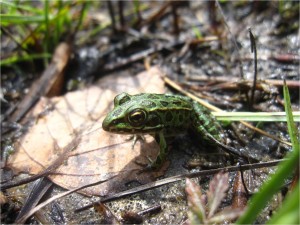It’s Tadpole Time
For the past few weeks and the next few, tadpoles will be hatching from eggs and turning into frogs and toads. This is the best time to teach your kids about the benefits of these amazing amphibians.
A Tadpole
Baby frogs have no legs and swim around like minnows in the shallow edges of permanent ponds and vernal pools. They are black “squiggles” with big heads and a tail – rather recognizable.
As a tadpole ages, it begins to grow appendages. The tail grows fatter with a thin layer of skin growing above and below the main part. Hind legs begin to develop followed by the front legs. The body thickens and the snout lengthens. Finally, the tail shrinks until it no longer exists.
Tadpoles feed on algae, aquatic zooplankton (teeny-tiny living animals that live in the water), insect larvae (like mosquitoes), and, as they become larger, they may eat other tadpoles or recently hatched fish. These little guys eat an incredible amount to accommodate their rapid growth rate.

The Benefits
As tadpoles grow, they begin to eat larger food to sustain themselves. Turning into predominantly land creatures, toads can consume close to 1000 insects in a day…no that’s not a typo. Smaller toad will eat less. Frogs, who spend a good amount of their time in the water, will feed on mosquitoes coming to lay their eggs, moths, dragonflies/damselflies, worms and caterpillars, and even other frogs.
Enabling frogs and toads to live in the garden can be exceptionally beneficial where bug problems are a concern. Caterpillar and slug damage can be detrimental to many plants. Increase your amphibian population and your problem will disappear.
Encouraging Amphibians
Don’t take those little tadpoles home with you: they are extremely sensitive to changes in their environment. If they are residing in a vernal pool (temporary water source) in or near a pathway, consider putting up some signs to inform others to go around. Give them the best chance to survive.
In your own garden, provide shelter and water: they will come for the food and stay for the accommodations. Shelter for a toad or frog isn’t what you would consider a 5-star hotel. No, a clay pot upside down and partially buried with an opening at the soil level will do just fine. Add a few logs or stick piles for additional shelter and a food source.
Water is a bigger subject that I will cover next week here. There are a number of factors to consider to ensure you’re providing the proper amphibian habitat where water is concerned. Stay tuned!




